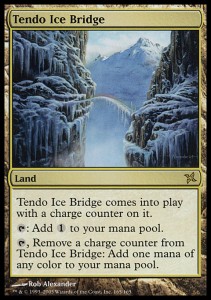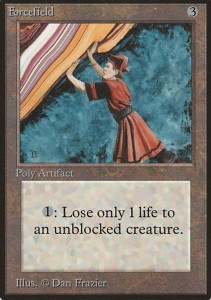After my article last week ("We Don't Need No Stinking Colors") I had a few solid suggestions in the comments that I would like to incorporate into the list and I would also like to do a more thorough walk through on the deck. I typically include some of the more nuanced interactions and in the interest of space I kind of skimped on that last week. There were a few requests made and I'd like to honor those interested. I also received a few requests for more information on the special project I'm working on with Trick. I'm happy to inform you that Trick will let you know in due time! All I'll say for right now is that I'm looking forward to working on it when the time comes.
 Let's start with a few changes. First of all, as much as I like Tendo Ice Bridge, it is entirely unnecessary. Unfortunately no matter how many counters are on it, Tendo is never going to tap for anything other than colorless. Instead we can run Urborg, Tomb of Yawgmoth. Urborg gives us the ability to do silly things with other lands and makes some of the less relevant lands in the deck (Eye of Ugin) into colorless producers if need be.
Let's start with a few changes. First of all, as much as I like Tendo Ice Bridge, it is entirely unnecessary. Unfortunately no matter how many counters are on it, Tendo is never going to tap for anything other than colorless. Instead we can run Urborg, Tomb of Yawgmoth. Urborg gives us the ability to do silly things with other lands and makes some of the less relevant lands in the deck (Eye of Ugin) into colorless producers if need be.
I'd like to take a second to discuss some of the decision process behind both this change, and the land base to begin with. This change allows for all of the previously color deficient lands to now tap for black, which becomes colorless. In addition, this allows Ancient Tomb the ability to tap for colorless without causing any pain. The damage dealing ability is attached with the ability to tap for two colorless mana. This change also lets Mishra's Workshop tap for colorless mana that does not have the restriction of needing to be used on an artifact. Note that this is different from something like City of Brass, which deals the damage when it becomes tapped, not when it produces the mana. If you have City of Brass in your deck and you tap it with an Urborg out you're going to take the damage regardless of the color you get. It's also worth noting that while Urborg makes your other lands into Swamps it is not itself a Swamp. This is important because all of the lands with a basic type have the intrinsic ability "Tap: Add {U}, {B}, {R}, {G}, {W}" to your mana pool, which violates the color restrictions of our general.
 Another change I would like to implement is to add Eternity Vessel to the deck. Adding Eternity Vessel lets us pay some nutty amount of life to make gigantic tokens off of Phyrexian Processor without needing to worry about silly repercussions like "attacking creatures". In order to make room for the Vessel I cut Forcefield. Forcefield is quite a bit more money than the Vessel, while essentially serving the same purpose! I have also discovered that Eternity Vessel is much more effective than Forcefield after I've cast Phyrexian Processor, making the Vessel the better option in my opinion.
Another change I would like to implement is to add Eternity Vessel to the deck. Adding Eternity Vessel lets us pay some nutty amount of life to make gigantic tokens off of Phyrexian Processor without needing to worry about silly repercussions like "attacking creatures". In order to make room for the Vessel I cut Forcefield. Forcefield is quite a bit more money than the Vessel, while essentially serving the same purpose! I have also discovered that Eternity Vessel is much more effective than Forcefield after I've cast Phyrexian Processor, making the Vessel the better option in my opinion.
There are a few abilities in the deck (aside from lands) that add mana to the pool. It's important to note which of these are and aren't mana abilities. One of the important reasons is because Rings of Brighthearth specifically says it can't copy mana abilities, and the other reason is because mana abilities are not put on the stack, they are just activated (or triggered) and resolve, they can't be countered or stifled. Almost all of the artifacts that actually tap for mana have mana abilities, but there is one notable exception, Blinkmoth Urn. I know that the Urn doesn't tap for mana, but it's triggered ability is also not a mana ability. This means that while the rest of your mana is safe, the Urn's ability can in fact be stifled/trickbinded, so be on the lookout!
There are also a few effects which make cards cost less. These effects are applied while you're casting the spell and taken into account after any effects which add on to the cost. This means that if I want to cast a Howling Mine and I have Cloud Key out and two Helm of Awakenings and my opponent has a Grand Arbiter Augustin IV, my Howling Mine is still free. This is because Howling Mine costs one mana, the Arbiter makes it cost three, and then any cost reductions are applied, reducing the cost to zero. Just about the only exception to this rule is Trinisphere, which always applies last. This means if we mix Trinisphere into the equation the Howling Mine will always cost at least three to cast, no matter how many cost reducers I have in play.
Fortunately, Rings of Brighthearth also foots the bill for any additional costs you need to pay.
While we're talking about wacky artifact interactions, let's talk about Rings of Brighthearth itself. Rings is a little odd in its execution. Rings of Brighthearth triggers when an activated ability is activated. This means that the trigger goes on the stack above the ability. When the trigger resolves you decide if you'd like to pay the two mana. This means if a player wants to stifle the trigger they need to do so before you have paid the two mana. The copy resolves before the original ability resolves. This means in a situation like Sensei's Divining Top you would draw a card from the copy before you get to draw from the original ability (meaning the Top is firmly on top of your library). Fortunately, Rings of Brighthearth also foots the bill for any additional costs you need to pay. This means abilities like Dreamstone Hedron's second ability, which requires a sacrifice can be copied without needing to sacrifice another card. What a great discount! Another common error with rings is the idea that you can pay two mana as many times as you'd like. If this were an activated ability that's true, unfortunately you can only pay two mana once per trigger.
Since triggered abilities seems to be a hot topic (angsty teens shop there!), let's continue down that train of thought. If there are multiple triggered abilities that are all controlled by the same person then they are put on the stack in the order of that person's choosing. This is particularly useful with Smokestack for instance. If you choose to put the sacrifice trigger on the stack first and the add a counter trigger above it, then you're forced to sacrifice a permanent. However, the other order lets you sacrifice zero permanents and then add a counter. Such ordering can be really quite useful when trying to maximize grief for an opponent while minimizing your own. If you combine Smokestack with any other triggers that occur at the beginning of the upkeep, Howling Mine for example, then you get to stack the three triggers however you would like, including something like the Mine in between the Smokestack triggers.
As for what happens when you miss a trigger... that's a different matter all together. There is literally a flow chart in the Infraction Procedure Guide [pdf] for how to handle a missed trigger. Let me make a little generalization here. If it has been caught before your next turn (and isn't optional) then we usually just go ahead and put the trigger on the stack. If it's optional, then you just chose not to do it. Remember that this is a casual format, and while that shouldn't absolve someone of being mindful of their triggers, fun is the most important goal!
I think that's a good summary of some of the more difficult rules interactions/changes that have been made. On to a few play strategies. Cast acceleration early and often. This deck is hungry for mana and we want to appease that hunger! Tutoring up Urza lands isn't necessarily a bad play, and in fact it's usually optimal. Given the chance to activate an ability, or hold back and activate the same ability with Rings of Brighthearth in play I almost always hold back and wait for the Rings to be active. Getting double the effect is just too good to pass up. Another good rule is that if you take a permanent from a player you need to use it against them. This rule was established while I was playing a mono blue deck dubbed layer 1/layer 2. Finally, when in doubt if you have the choice between a serious play and something random and fun, choose random and fun, it makes the games go a little better for everyone!
I think I've covered the ins and outs of the deck pretty thoroughly, but if you still have any questions feel free to post them and I'll do my best to respond. Join me next week when I work on that tokens deck I was promising, and maybe give you a few details of things to come. Until then this is Benjamin McDole giving you a hundred reasons to play magic!























